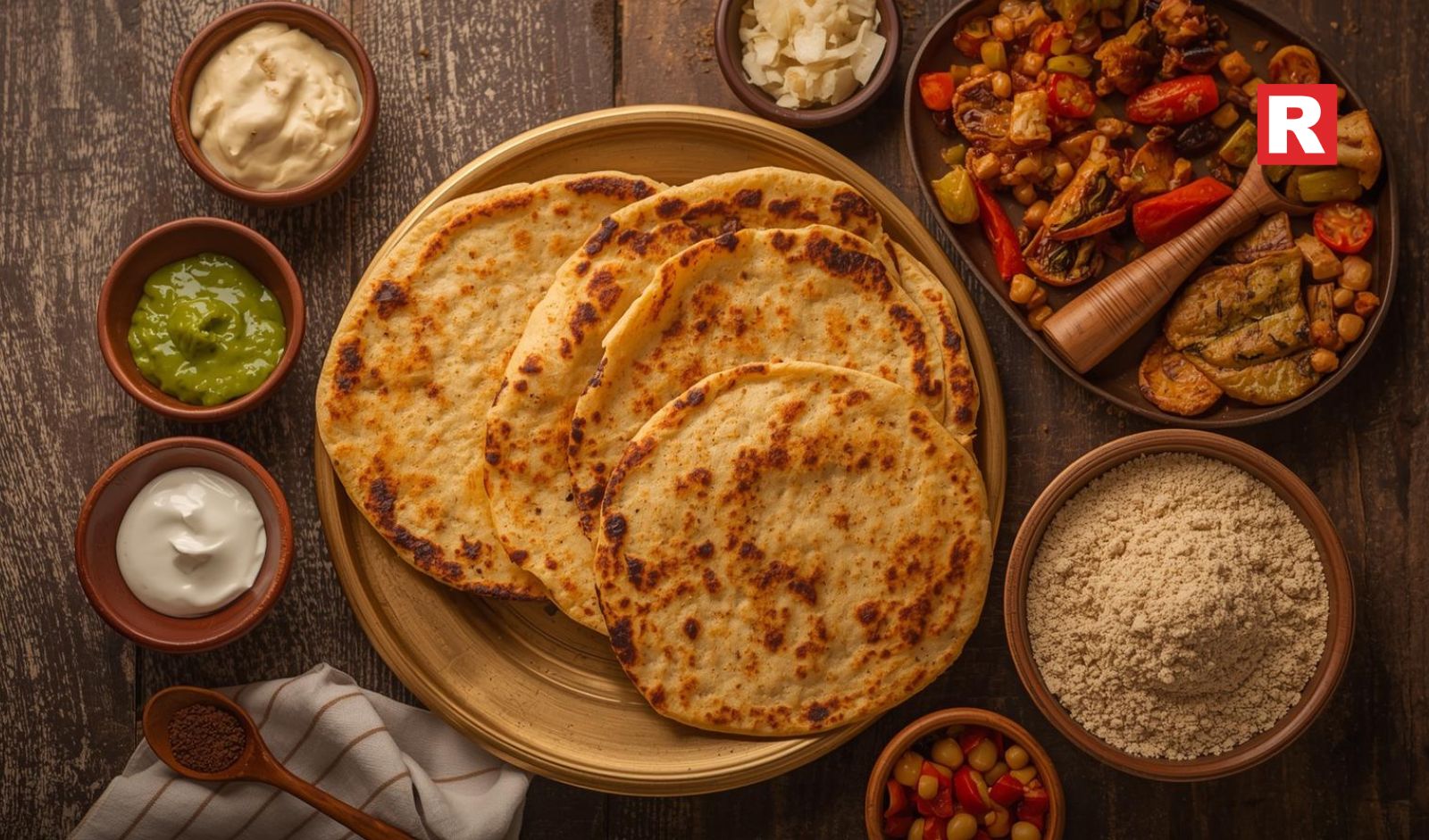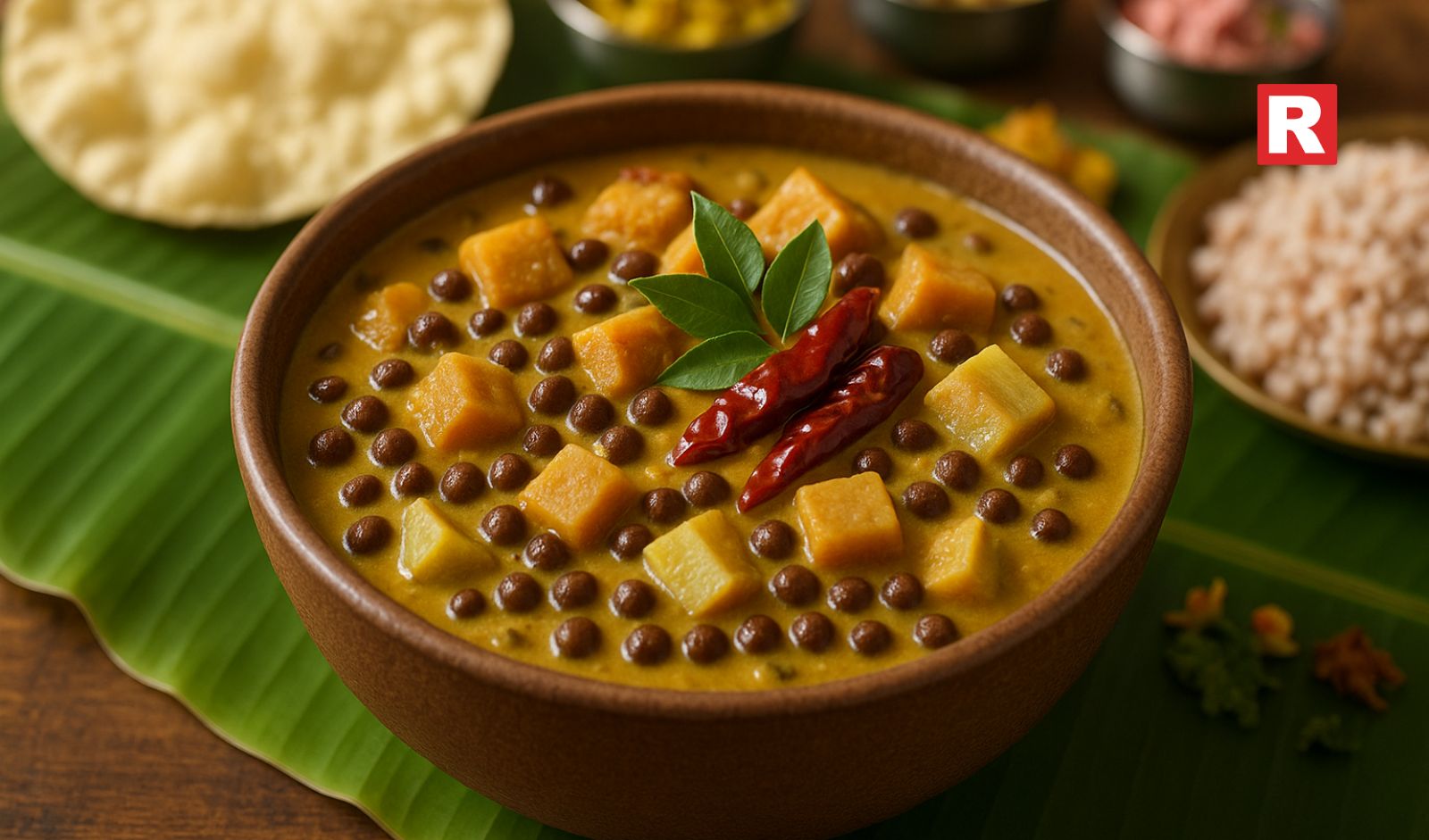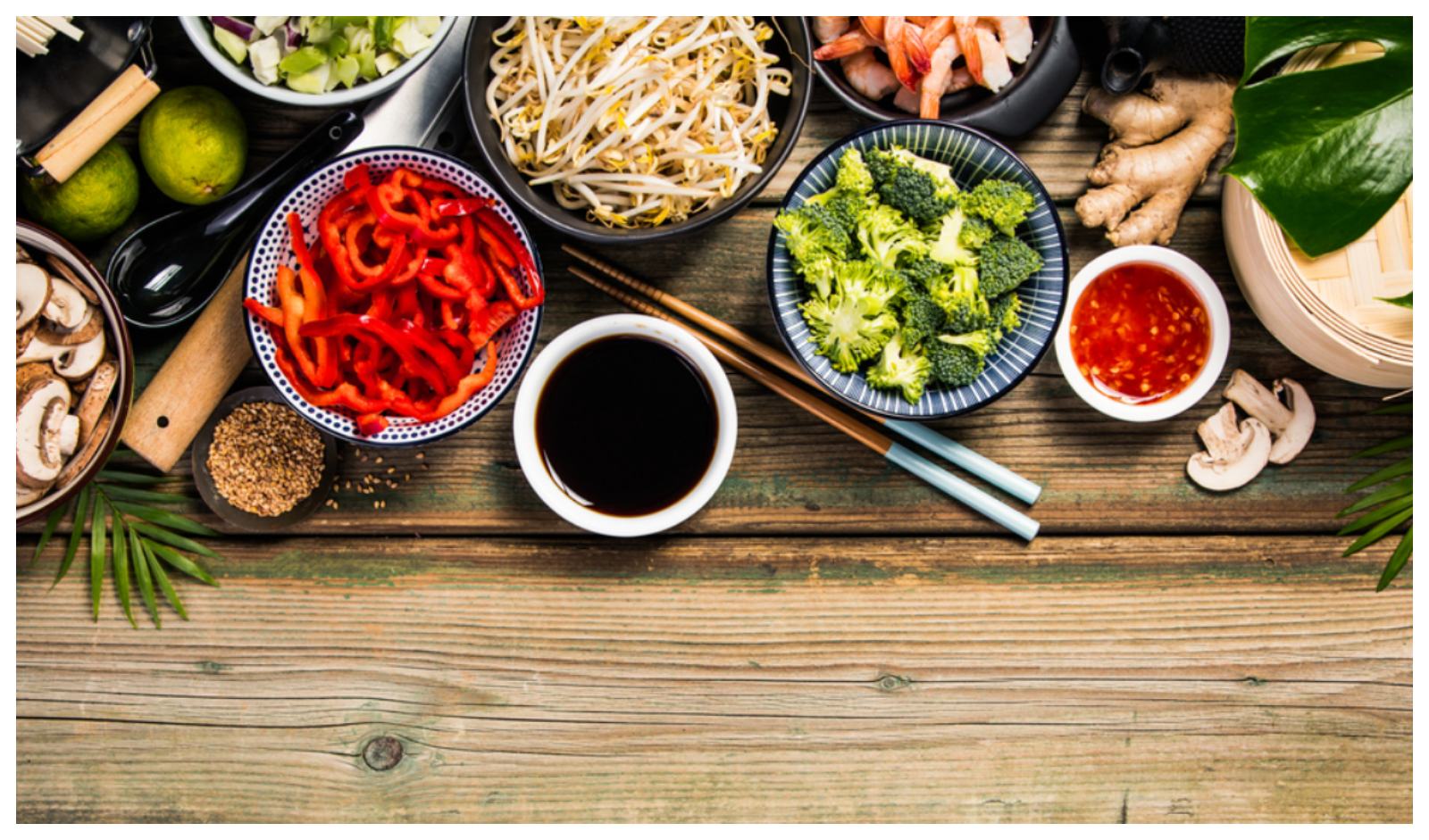
People in Kerala love Beetroot Pachadi, especially during Onam Sadya and other holidays. This colorful dish is a great side dish for rice because it has the sweetness of beetroot, the tang of yogurt, and the smell of coconut. There are small differences in the recipes depending on where you live. For example, there is the Malayalam style Beetroot Pachadi recipe, the Andhra style Pachadi, and even versions without coconut.
This guide has everything you need to know about Beetroot Pachadi, from a simple recipe to its health benefits and different ways to make it.
What Exactly is Beetroot Pachadi?
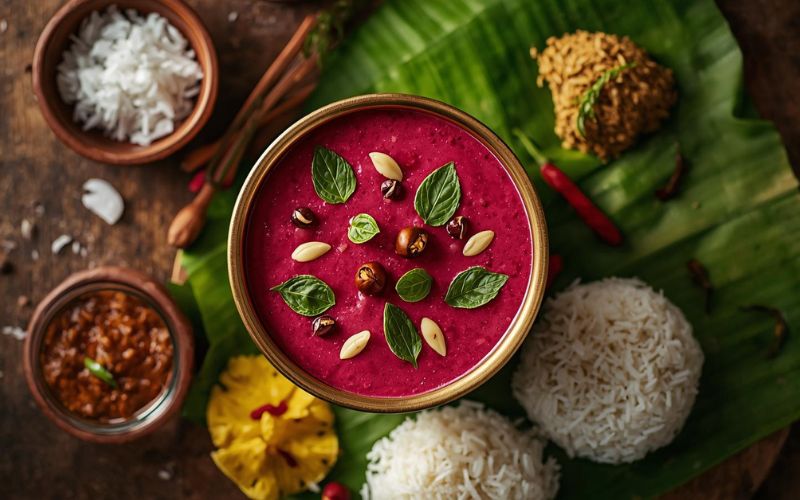
Beetroot Pachadi is a South Indian dish that is similar to raita. It is made by mixing cooked beetroot with a paste made from ground coconut and mustard and then mixing it with curd (yogurt). Adding curry leaves, mustard seeds, and dry red chilies to the dish gives it a tasty finish.
Pachadi tastes different from the usual North Indian beetroot raita because it has coconut and curry leaves in it.
Also read: Kootu Curry Recipe
Ingredients for Beetroot Pachadi (Malayalam Recipe)
Here is a list of the usual ingredients used in a Malayalam recipe for beetroot pachadi:
- 2 medium beetroots, grated or finely chopped
- ½ cup grated fresh coconut
- 2–3 green chilies
- 1 tsp mustard seeds
- 1 small piece ginger
- 1 cup thick curd (yogurt)
- ½ tsp turmeric powder
- 1–2 dried red chilies
- 1 sprig curry leaves
- 2 tsp coconut oil
- Salt as needed
Step-by-Step Beetroot Pachadi Recipe
- To cook the beetroot, put grated beetroot, turmeric, salt, and a little water in a pan. Cook until soft.
- Make the paste out of coconut – With a little water, grind the grated coconut, green chilies, ginger, and half of the mustard seeds into a smooth paste.
- Mix with beetroot: Stir this paste into the cooked beetroot and let it simmer for 2–3 minutes.
- Mix in some yogurt after the mixture has cooled down a bit.
- To make tempering, heat coconut oil and add mustard seeds, curry leaves, and dry red chilies. Add this to the pachadi.
- Serve: As part of a Sadya meal, Beetroot Pachadi is ready to be served with steamed rice.
Beetroot Pachadi Variations
- Beetroot Pachadi without Coconut: For a lighter version, mix cooked beetroot with curd, salt, and a tempering of mustard and curry leaves instead of coconut paste.
- Andhra Beetroot Pachadi is spicier than other styles. It has a sour taste because it uses tamarind pulp and red chilies instead of Kerala style.
- If you're short on time, just cook the beetroot, mix it with curd, and add a quick tempering. You don't need to grind anything.
- Pineapple Pachadi is a festive version made with pineapple instead of beetroot. It is also very popular in Kerala Sadya.
Also read: Sattu Paratha Recipe
Health Benefits of Beetroot Pachadi
Beetroot Pachadi is not only delicious but also highly nutritious:
- Rich in Iron & Folate: Helps in improving blood circulation and preventing anemia.
- Gut-Friendly: Yogurt provides probiotics that support digestion.
- Low-Calorie Side Dish: Makes it ideal for health-conscious eaters.
- Detox Friendly: Beetroot aids in liver detoxification.
- Heart Health: Coconut oil and curry leaves add good fats and antioxidants.
So, if you’re asking “Is beetroot pachadi good for health?” – the answer is a big yes. It’s a wholesome dish that balances taste and nutrition.
Pro Tips to Make Perfect Beetroot Pachadi
- Use thick curd every time to keep the pachadi from getting watery.
- Don't add curd to the beetroot mixture while it's still hot. Let it cool down a bit first to keep it from curdling.
- Use coconut oil to temper the food; it brings out the real Kerala flavor.
- Add green or red chilies to change the heat level to your liking.
- If you want a smoother texture, grate the beetroot; if you want a chunkier pachadi, chop it up.
What Goes Well with Beetroot Pachadi?
The best things to eat with beetroot pachadi are:
- Avial, Erissery, Parippu Curry, and Rice are some of the Kerala Sadya dishes.
- Steamed rice with sambar or rasam is easy to make.
- You can also eat it as a side dish with chapati or dosa.
One of those dishes that instantly brings the tastes of Kerala to your plate is Beetroot Pachadi. If you like South Indian food, you have to try this pachadi. It comes in three different styles: the traditional Malayalam style, a simple style without coconut, and a spicy Andhra style.
Beetroot Pachadi is a great dish to make for a special occasion or to add some color and health to your thali.

Sattu Paratha is a very important part of a traditional Indian breakfast. This simple paratha stuffed with roasted gram flour comes from Bihar and Jharkhand. It's a full meal on its own—tasty, filling, and full of nutrients. For a lot of families, food is more than just food; it's a way to connect with their roots. This article is your one-stop shop for everything you need to know about Bihari-style cooking, whether you're trying the real thing, looking for versions from Hebbars Kitchen or Nisha Madhulika, or asking Sanjeev Kapoor for expert advice.
What Makes Sattu Paratha Special?
Sattu is roasted Bengal gram flour that is often called "poor man's protein." Because it is cheap, high in protein, and gives you energy, it has been a staple for farmers and workers for hundreds of years. Biharis even say that a meal of sattu can keep you going all day.
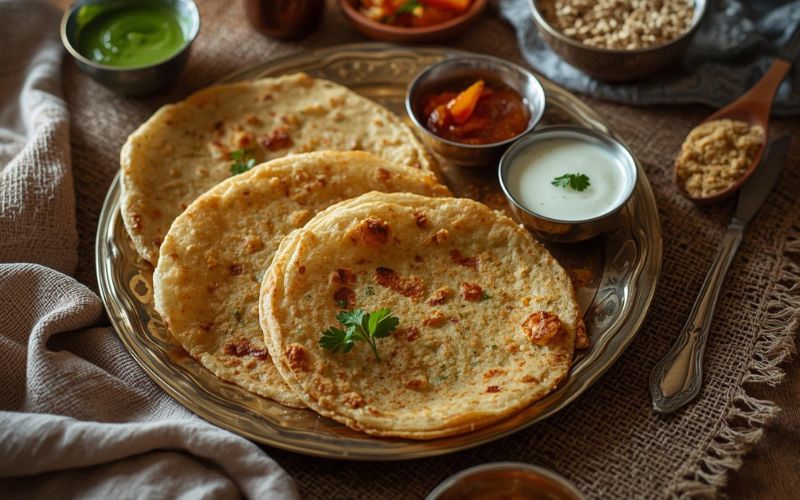
Sattu Paratha tastes different from regular stuffed parathas like aloo or paneer because it has a unique earthy flavor from roasted gram and mustard oil. This mix of taste, health, and history is what makes it last forever.
Ingredients of Sattu Paratha
To make this healthy meal, you will need:
For the dough
- 2 cups of flour made from whole wheat
- A little bit of salt
- 1 teaspoon of ghee or oil
- Water, as needed
For the Filling
- 1 cup of sattu (roasted gram flour)
- 1 medium onion, cut up very small
- 2 green chilies, finely chopped
- 1 tsp of ginger-garlic paste
- 2 tablespoons of chopped fresh coriander leaves
- 1 to 2 teaspoons of pickle masala or amchur (for tang)
- ½ teaspoon ajwain (carom seeds)
- Salt, to taste
- 1 to 2 tablespoons of mustard oil (this is what gives it its real flavor)
- A few drops of lemon juice
Step-by-Step Sattu Paratha Recipe
Step 1: Make the Dough
- Mix together the ghee, flour, and salt. Slowly add water and knead the dough until it is soft.
- Put a wet cloth over it and let it sit for 20 to 25 minutes to make it more elastic.
Step 2: Get the stuffing ready
- Put the sattu, onion, chili, coriander, spices, and ajwain in a bowl and mix them together.
- Add lemon juice and mustard oil; these are what keep the stuffing moist and tasty.
- Change the spices to suit your taste.
Step 3: Put the Paratha together
- Make equal balls of dough and roll each one into a small circle.
- Put 2–3 spoonfuls of stuffing in the middle.
- Carefully seal the edges and roll the paratha gently so that the stuffing doesn't spill out.
Step 4: Roast the Paratha
- Put the rolled paratha on a hot tawa.
- Cook on medium heat with ghee or oil until golden brown spots show up.
- Serve with curd, pickle, or chokha while it's hot.
Pro Tips to Make Perfect Sattu Paratha
It's easy to make a good Sattu Paratha, but it's hard to make a perfect one. Here are some ways to make your parathas better:
- Moisture is key: Sattu is usually dry, so adding mustard oil, lemon juice, or a little bit of water will keep the filling soft and tasty. The paratha will break or taste bland if the stuffing is too powdery.
- Make sure the filling and dough are even: If you put too much filling in, the paratha will tear, and if you don't put enough in, it will be flat. As a general rule, the filling should weigh about half as much as the dough ball.
- Let the dough rest: Let it sit for at least 20 to 25 minutes. This makes gluten relax, which makes the paratha softer and easier to roll.
- How you roll matters: Roll gently and with even pressure. If you roll too hard, the stuffing might come out. If it does, just use a little dry flour to fix it.
- Cook on medium heat. If the heat is too high, the paratha will burn and the inside will be raw. If the heat is too low, the paratha will be chewy. A tawa that is medium-hot makes the outside crispy and the inside soft.
- When roasting, don't forget the ghee or oil. They give the paratha its flaky layers and rich flavor. You can use ghee instead of mustard oil if you want something more decadent.
- Serve right away: When served hot, sattu parathas taste the best. Wrap them in a cotton cloth to keep them soft if you're making them ahead of time.
Also Read: Kootu Curry Recipe
Why is My Sattu Paratha Dry?
Dryness is one of the most common complaints. Some of the reasons are:
- Putting less oil in the stuffing. In the Bihari style, mustard oil is a must.
- The dough is too stiff, which makes the paratha hard.
- Not serving right away—parathas taste best when they're hot.
To make it more fusion-like, add a spoonful of curd or mashed potato to the stuffing.
Health Benefits of Sattu Paratha
Sattu Paratha is not only tasty, but it's also one of the healthiest traditional Indian breakfasts. Here's why you might want to add it to your diet:
- Sattu is roasted chana flour, which is a great source of plant protein. It helps muscles heal and gives you energy for a long time, which is great for kids who are growing and adults who work.
- High in Fiber: Sattu and whole wheat are high in fiber, which keeps digestion moving, stops constipation, and helps keep the gut healthy.
- Cooling Effect on the Body: Sattu is traditionally eaten in the summer because it cools the body and stops heat strokes. This is why it is popular in Bihar and Jharkhand, where it is hot.
- Balances Energy Levels: Sattu releases energy slowly, which keeps you full longer than snacks made with refined flour. Best for diabetics when eaten with little ghee.
- Weight Management: Because it keeps you full for a long time, it stops you from wanting things you don't need, making it a great choice for people who are trying to lose weight.
- Heart-Friendly: Mustard oil is good for your heart when you eat it in moderation because it is high in omega-3s and antioxidants.
- Sattu is full of nutrients like calcium, magnesium, and iron, which are important for strong bones and a strong immune system.
Calorie Check: A medium-sized Sattu Paratha has about 220 to 250 calories. When you eat it with curd and chutney, it becomes a healthy, balanced meal that isn't too heavy.
Variations of Sattu Paratha
The classic Bihari-style Sattu Paratha is the best, but you can try these fun variations based on your taste and the event:
- Bihari Style: The stuffing has raw mustard oil, ajwain, and pickle masala in it. It tastes sharp and earthy, and it's the most real version.
- Without Stuffing: Instead of making a filling, mix sattu right into the dough. This version is easier to roll, which makes it great for beginners. Compared to the stuffed one, it's lighter but not as tasty.
- With Vegetables: Mix in some grated carrot, radish, or beetroot to the stuffing. This not only makes the taste better, but it also makes the nutrition better, which is great for kids who don't like plain sattu.
- For a softer, creamier stuffing, mix sattu with paneer or mashed potatoes. This mix makes the paratha wet and easy for kids to eat.
- Inspired by Celebrity Chef Sanjeev Kapoor, he says to try using herbs like mint and a mix of ghee and oil for roasting to give it a restaurant-like touch.
- Hebbars Kitchen and Nisha Madhulika have online versions. These often make the recipe easier by showing you how to do it step by step and with videos, which is great for people who are cooking for the first time.
- Mini Sattu Parathas: Instead of making big ones, roll out smaller ones that are the right size for snacks. Great for lunch boxes or as a party starter.
Cultural Significance
Bihar's identity is tied to Sattu Paratha, which is more than just food. People in rural areas cook it every day, especially in the summer when heavy curries can be too much. Many Bihari immigrants also bring packets of sattu flour with them when they move abroad, keeping this tradition alive around the world.
Making Sattu Paratha at home is a fun thing to do if you've never done it before. It's simple, healthy, and based on tradition, so it's great for anyone who wants real Indian flavors and a boost in nutrition. You can see why people have loved this dish for generations when you serve it with curd, chutney, or chokha.
So the next time you ask yourself, "What is the healthiest paratha to make at home?" — you already know the answer: Sattu Paratha.

Kootu Curry, or Koottukari, is more than just another vegetarian curry. It's a key part of Kerala's Onam Sadya and other festive meals. This dish is known for its hearty texture and comforting flavors. It combines legumes like black chana (kadala) or Bengal gram with vegetables grown in the area, like yam, ash gourd, raw banana, or pumpkin. The roasted coconut base of Kootu Curry is what makes it stand out. It has a nutty, fragrant flavor that is very Kerala.
Every part of Kerala has put its own spin on Kootu Curry, from the Brahmin homes in Palakkad to the feasts in Kannur and the kitchens in Malabar. This makes it one of the most flexible dishes in Kerala cuisine.
Also Read: Sattu Paratha Recipe
The Story Behind Kootu Curry
Food is very important to Kerala's culture and celebrations. The big Sadya meal served on banana leaves during Onam has more than 20–25 dishes, and Kootu Curry is always the main dish. Kootu Curry is different from the light stews and yogurty curries in the spread because it has a strong, earthy flavor from the mix of roasted coconut, black pepper, and curry leaves.
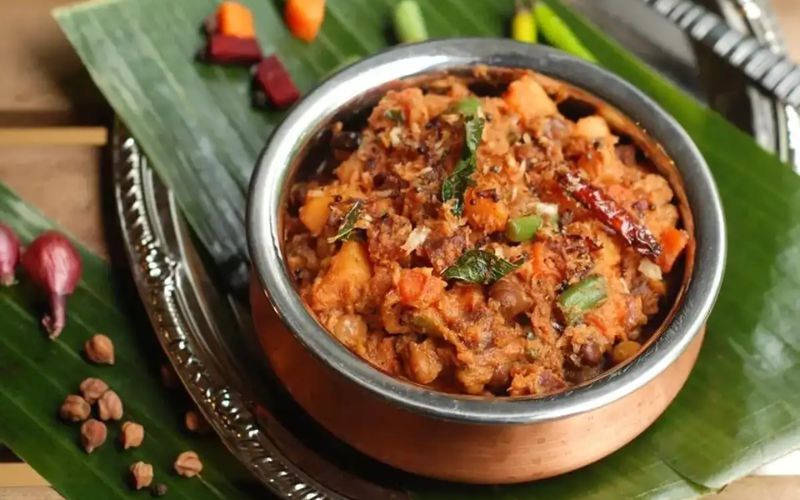
The recipe is passed down from generation to generation in many families. The Palakkad style is simpler and has a hint of coconut, while the Kannur style is stronger, spicier, and has more roasted coconut. The Brahmin version doesn't use onions or garlic, so it's a sattvic dish.
Ingredients in Kootu Curry
A normal Kerala-style Kootu Curry recipe calls for:
- Legumes: Bengal gram or black chickpeas (kadala) soaked overnight and then cooked under pressure
- Yam, raw banana, ash gourd, or pumpkin (often in combination) are some of the vegetables.
- Turmeric, black pepper, red chili powder, green chilies, and curry leaves are some of the spices used.
- Coconut base: Freshly grated coconut roasted with cumin and chilies until golden brown, then ground into a paste.
- Coconut oil, mustard seeds, curry leaves, and dried red chilies are used to temper.
The end product is a thick, mildly spicy curry that tastes great.
Step-by-Step Kootu Curry Recipe (Kerala Style)
- Cook the legumes – Pressure cook soaked black chickpeas or Bengal gram until tender.
- Prepare vegetables – Dice yam, raw banana, or pumpkin into medium cubes. Cook until soft but not mushy.
- Roast and grind coconut – In coconut oil, roast grated coconut with green chilies and cumin until golden brown. Grind into a coarse paste with little water.
- Mix everything – Add the cooked vegetables and legumes together in a pot, stir in the coconut paste, and simmer until flavors meld.
- Temper to finish – Heat coconut oil, splutter mustard seeds, toss in dried red chilies and curry leaves, and pour over the curry.
- Serve hot – Kootu Curry is best served with steamed rice, Kerala matta rice, or as part of a traditional Sadya meal.
Regional Variations of Kootu Curry
Kootu Curry is still popular with foodies because it comes from many different regions. The basic ingredients of the dish are still the same: legumes, vegetables, and roasted coconut. However, each community in Kerala has added its own special touch. Let's take a closer look at the most popular styles:
1. Kootu Curry in the Style of Palakkad
The Palakkad area, which is next to Tamil Nadu, has a cuisine that is heavily influenced by both Kerala and Tamil Brahmin traditions. Compared to northern Kerala styles, the Palakkad version of Kootu Curry is not as spicy or hot. The focus is on how naturally sweet yam, pumpkin, or raw banana is when mixed with freshly ground coconut. The coconut here is only lightly roasted, which means it smells good but doesn't change color. This is different from the Kannur version. This makes it lighter and more sattvic, and it is often served at temple feasts and religious ceremonies.
2. Kootu Curry in the Brahmin Way
The Brahmin community makes Kootu Curry as a sattvic dish, which means it doesn't have any onions or garlic and usually has fewer spices. You have to have black chickpeas (kadala) and roast the coconut slowly. The dish tastes earthy but not spicy because it has pepper, cumin, and curry leaves in it. This version shows how the Brahmins value food that is soulful, healthy, and easy to digest. They often make it for special occasions like weddings and pujas.
3. Kootu Curry in the Style of Kannur
The Kannur version is very spicy, bright, and bold. Roasting the coconut until it is golden brown or even deep brown gives the curry a strong, nutty flavor. A lot of black pepper is used, sometimes even more than chili powder, which gives it a sharp kick. The Kannur style is richer and heartier because it comes from the coast, where strong flavors are preferred. This version is a must-have at big Onam feasts in northern Kerala, where food is celebrated with lots of flavor and plenty of it.
4. Recipe for Malabar Kootu Curry
The Malabar region, which includes Kozhikode, Kannur, and parts of northern Kerala, has its own unique version of Kootu Curry. The food here is more festive and rich. Cooks can add pumpkin or ash gourd for sweetness along with the usual yam and banana. Frying coconut until it is deep golden and smells good makes a rich base for the curry. A little bit of jaggery syrup is sometimes added to balance the flavors. This gives the dish a slightly sweet taste that goes well with other Sadya dishes. People like the Malabar style for weddings and big family meals because it shows that they are welcoming.
Why Restaurants Should Feature Kootu Curry
Authentic Kerala Touch – No Sadya or festive South Indian thali feels complete without Kootu Curry. Adding it to your restaurant’s menu brings cultural depth and authenticity.
Healthy and Vegan – Naturally plant-based, rich in protein from legumes, and cooked in coconut oil, this curry is a hit with health-conscious and vegan diners.
High Demand During Festivals – Onam, Vishu, and weddings see a surge in demand for traditional Kerala dishes, with Kootu Curry often being a must-have in catering menus.
The Kootu Curry Kerala style recipe is more than just a taste; it also has the cultural essence of Kerala's festivals, traditions, and community feasts. From Palakkad to Kannur, each region has its own food story to tell. For people who cook at home, it's comfort food. For restaurant owners, it's a crowd-pleaser that can make a holiday menu better.
Don't forget to include Kootu Curry in your next Kerala feast. It's a dish that honors the balance of flavor, health, and tradition.

In a candid chat with Franchise India, Chef Shipra Khanna talks about her journey in Master Chef II, the menu tweaks she applies and the F&B trend in the industry.
How does it feel to be heard as Master Chef India?
It sounds great to be heard as Master Chef winner. It is a great platform for a person like me who is so passionate about food. I always experimented with my food.
Trace your journey from winning Master Chef to Spice Route?
Winning Master Chef was a platform for me to be there where I wanted to be. Now I am exploring food and ingredients that we Indian’s haven’t come across. Even the people in the remote or the sub urban areas don’t know much about it. That is my spice route in India and abroad and I travel, I see the world, I cook with new ingredients.
What is the current menu trend and what can be the next?
According to me or as I always believe the future of India is regular dining with good flavours, less spicy food, good portion size with less oil. The menu needs to be very short and the food should be affordable. We as Indian do not want to make money but as I chef I would like maximum people to taste what I cook.
People today have become more conscious when taking food. What is the reason?
Gastronomy is the art and science of food where you can divide and break down the food to the fat, the vitamin, the minerals or the protein it has. So ultimately you have a chance to know whether it is healthy or unhealthy.
What menu tweaks do you apply in your recipe?
I use a blend of flavours like the Italian and Indian, Indian and French and many more. I have opened my restaurant in Ahmedabad, named H.O.T, in which I have introduced fusion and Indian cuisine.
What should a restaurateur look for in a chef?
A restaurateur should always look at a chef who is flexible, open to ideas and experiment with new because everybody wants to go by the new trends. So, the main thing that a chef should have is a good grip on food.
Tell us about the business plan that you made before starting your restaurant?
My restaurant is located at a very posh area in Ahmadabad and location was the first thing that I have worked upon. Marketing and the PR are the biggest trick we are working on.
Copyright © 2009 - 2025 Restaurant India.





